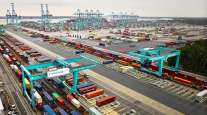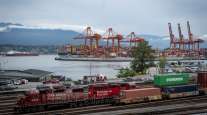Senior Reporter
West Coast Ports Report Lackluster October

[Stay on top of transportation news: Get TTNews in your inbox.]
Three West Coast ports saw significant drop-offs in cargo volume last month, the latest indication that the United States’ long-simmering trade dispute with China is impacting operations at the nation’s ports.
The Port of Los Angeles, the nation’s busiest facility, saw a 19.1% decline in 20-foot-equivalent units (TEUs) container volume, moving 770,188 compared with 952,553 in the same period a year ago. Imports and exports were both down 19%. The drop-off also means the Los Angeles port is 90,697 TEUs behind last year’s record pace, having processed 7,861,964 TEUs through the first 10 months, compared with 7,723,159 at this point last year.
Port Executive Director Gene Seroka and other officials were in Washington on Nov. 12, and he is sounding the alarm over the damage being done to the economy because of the ongoing trade battle and the resulting tariffs on hundreds of billions of dollars worth of products.

Seroka
The port released a study by global consulting group BST Associates that examined the impact of tariffs on the Port of Los Angeles and neighboring Port of Long Beach.
“Every urban, suburban and rural community across our nation benefits from imports and exports moving through the San Pedro Bay ports, and ongoing tariffs are putting those benefits at risk,” Seroka said. “Some regions and industries are already feeling the pain, and the damage to jobs, income and tax revenue could be crippling down the road.”
The study said as many as 1.4 million jobs could be at risk if the tariffs remain in place.
“The administration’s imposition of tariffs as high as 25% has raised costs for everyday consumers of basic products such as food and clothing, home appliances and our ubiquitous iPhones,” said Rufus Yerxa, president of the National Foreign Trade Council. “That’s bad enough, but they also cause untold damage to our most competitive manufacturers and farmers, rendering them less competitive at home and abroad as production costs increase and foreign retaliation shrinks their exports. It is now clear that a tariff war without sensible constraints is a lose-lose proposition for the vast majority of Americans.”
At the Port of Los Angeles, officials said October marked the 12th consecutive month of declining U.S. exports and 25% fewer ship calls.
Economist Paul Bingham follows transportation and ports for IHS Markit in Los Angeles. He shares the ports’ concerns.
“The heads of those ports on the West Coast are speaking directly to their own future in terms of cargo-handling potential and what trade policy does and how it effects it,” he said.
Bingham noted that for the trucking industry, less cargo volume at the ports could mean fewer jobs, especially for those involved in port drayage.

Containers at the Port of Long Beach. (Port of Long Beach)
The cargo volume numbers were only somewhat better at the nearby Port of Long Beach, where the container figures also were down, albeit not as much as at Los Angeles.
Long Beach saw a 2.4% drop as it processed 688,425 TEUs compared with 705,408 in the same period a year ago. Even with the decline, the port said it had the second-best October in its 108-year history.
For the year, Long Beach is down 5.4% compared with the first 10 months of 2018.
“As the trade war lingers, these tariffs continue to impact the U.S. economy and have created uncertainty for the business of importers and exporters,” Port of Long Beach Executive Director Mario Cordero said. “We are hopeful for a prompt resolution of the tariff situation between the U.S. and China. In the meantime, we are moving forward with capital improvements that should bring long-term growth.”
The Port of Oakland reported a 10.3% drop in total TEU volume in October, processing 204,881 TEUs compared with 226,052 in the year-ago period. However, even with the drop, export volume increased by 10.8% when compared with 2018. The port said it believes the increase was caused in part by the hope the U.S.-China trade dispute may be easing.
“Our export customers have demonstrated their resilience throughout this tariff standoff,” Port of Oakland Maritime Director John Driscoll said. “For their sake, we hope the conflict is resolved and overseas business can grow even more.”
The Port of Oakland is a major supplier of agriculture products overseas as ag commodities account for about 37% of all international exports shipped from Oakland. The farm goods range from containerized rice to dried fruits, nuts and refrigerated beef.
Port of Oakland names Danny Wan Executive Director;
former Port Attorney, City Council member, takes over at key moment https://t.co/5XoEVqc08J #Oakland #maritimeexecutive #DannyWan #ports #portexecutives #portdirector #portexecutivedirector #PortofOakland #AAPA_Seaports pic.twitter.com/S81wQtx4Wr — Port of Oakland (@PortofOakland) November 14, 2019
Meanwhile, Danny Wan was appointed executive director at the Oakland port on a permanent basis Nov. 14. He had been serving as interim executive director since last summer. Wan succeeds Chris Lytle, who retired in July after six years in the position.
Want more news? Listen to today's daily briefing:




